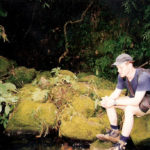The following is an excerpt from an interview with Asher Ross for an upcoming book from Kinfolk on souvenirs.
What thoughts do you have on bringing home souvenirs for friends and family? If seeking to preserve an ephemeral experience in an object is often hopeless, even for ourselves, what does it mean to try to transmit that experience to a loved one through an object?
The souvenirs we bring home for family are different from the ones we keep for ourselves. These objects are less about the ephemeral experiences and specific settings of travel than they are about the human relationship itself. Not unlike the Japanese “omiyage” ritual, they show family members that the traveler was thinking of them in some exotic (and often expensive to reach) environment, far from home. I recall when some working-class friends from Kansas visited me in Paris during the time of my annual summer writing class there, they got Tour de France hats — not because they were fans of bicycle racing, but because the hats had the same yellow/black coloring as Wichita State University sports uniforms. I thought that was great — it gave them a gift that was clearly French, yet familiar enough to evoke associations of home.
What relationship do you see between the historically religious origins of the souvenir and our own perhaps futile desire to preserve a moment of elation, self-understanding, or transcendence on holiday by buying or taking something from the scene where the feeling transpired? I suppose I’m asking if you see an element of the souvenir-impulse that connects us through time.
I think there is a lot of connection between personal souvenirs and religious ones — in part because today’s travelers are (in the way that they travel for its own sake, rather than for commerce or war) the legacy of religious pilgrims. I suppose certain religious souvenirs are standardized (like the palm badges of Jerusalem pilgrims) and hence have a social/status function that personal souvenirs don’t — but presumably the religious experience of a pilgrimage site is somewhat similar, emotionally, to the subtle epiphanies and joys of personally motivated travel. I think the meaning of these objects changes over time. Just as, say, the English pilgrim’s souvenirs of Canterbury might shift in importance once that pilgrim has also made it to Santiago and Rome, a childhood souvenir of a local state fair might in time carry less personal resonance once that same traveler has gone to festivals in Kenya and Serbia and China and brought home more exotic souvenirs. Inevitably, the meaning of any souvenir can shift over time.
As you explore in the book, the question of the authentic souvenir can be turtles all the way down. What, to you, imbues a souvenir with personal authenticity, or to borrow a phrase from chapter 7, existential authenticity?
Personal or existential authenticity is something I don’t think I properly considered before I started researching the Souvenir book. It’s not uncommon to put a lot of thought into how externally authentic a given souvenir object is (was this sweater really made in Norway? was this Vanuatu Kastom mask built for ceremonial purposes or for the tourist market?). But it’s easy to forget how even our quest for external authenticity can be about imbuing our travels with a sense of existential authenticity — a sense that this object represents a meaningful moment in the context of our own lives. I think this is why novice travelers tend to buy more souvenirs than experienced travelers — why all of us are more attuned to certifying our early travels with souvenirs than we are our further journeys. When travel is new and exciting, even a Chinese-made keychain in a Paris souvenir shop can certify a trip to Europe on a personal level. Years later, the same traveler might laugh at his prior compulsion to get that cheap keychain, and instead shop for wine or perfume or art that reflects a more nuanced relationship with a place like Paris. But on an existential level both purchases — the keychain and the wine or art — reflect an authentic sense of interaction with the place.
Why thimbles? I inherited a rack of them and loved them as a child.
Thimbles became a popular souvenir during that initial wave of 19th century mass production that also gave us the souvenir spoon and the postcard. This was a time when sewing was far more common than it is now, so the thimble was a potentially useful item — but as much as anything it became popular because thimbles are small and cheap. One can buy a thimble that says “Piccadilly Circus” or “Buffalo”, and it certifies the journey while also being easy to tuck away and bring home. Like souvenir spoons, thimble racks became popular because (thanks to their size and relative cheapness) thimbles transformed into a go-to keepsake in tourist areas — even for people who weren’t particularly interested in sewing. In this way, the symbolic meaning of the souvenir thimble far outstrips any functional meaning it might have once had.
This may be covered in the final chapter, so forgive me, but which of your own souvenirs have best stood the test of time? Have any of your souvenirs changed meaning on you?
I think that the meaning of almost all of my souvenirs have changed over time. The masks that I collected during my first months of traveling through Asia have become less about Asia than the naive, optimistic traveler I was at that age. Some of the cheap souvenirs I got in Australia remind me not of Australia but of the fact that I went there right after I got my house in Kansas — and hence they are as much about pride in having a house to hang souvenirs in than they are about the places in Australia where I bought them. One of my most reliably evocative souvenirs is a boat propeller from a Laotian fishing craft I drove hundreds of miles down the Mekong River in 1999 — not because of its craft or function as an object, but because of all the effort and risk and excitement that went into that adventure. Nothing for sale at a gift shop could ever compare to the visceral memory of breaking all those boat propellers in the shallows, and saving one of them for posterity. I think, too, that once you display travel souvenirs at home, they mix in with other keepsakes — items like the Zippo lighter that once belonged to my paternal grandfather (a man I never met), or a plastic cup from Kauffman Stadium the year the Kansas City Royals won the World Series, or the eagle feather I found on a walk less than a mile from my home. In this way, my travel souvenirs are contextualized by life-souvenirs (some of which predate my birth) that also carry a lot of personal meaning.
What about the relationship between souvenirs and mementos mori?
I think souvenirs inevitably become memento mori — though in a sense anything that marks a time in our ephemeral lives can become a memento mori. Because travel takes us away from the lives we live at home — and outside of our habits and comfort zone — it lends itself to a kind of intensification of life can remind us of the importance of each passing moment and experience. In this way souvenirs, when collected in the moment, are a reminder of the attempt to hold onto and honor experience — and then, back home, they are a reminder of the fleeting, holy nature of past experiences.
Have you observed any recent evolutions of the souvenir, perhaps since writing your book, that you’d like to note?
In my book I didn’t dig too deeply into the notion of photos as souvenirs — that’s almost its own, separate book — but the exponential ease with which we can now take photos (compared to even the relatively recent past) has revolutionized the role that photos play as souvenirs of experiences like travel. In a way the travel photo is becoming less and less a separate category from the photos we take in our daily lives. A generation or two ago, when relatively expensive film cameras and photo-lab processing were the norm, the act of taking photos was reserved for special occasions like weddings and graduations and trips to distant places. These days, with most everyone’s phone doubling as a digital camera, photos aren’t reserved for special occasions — they are taken constantly, to mark (and even perform amid) all manner of occasions. In a way, the ubiquity of photos in everyday life has made photos less remarkable in the travel context — and hence concrete souvenir objects collected on a journey are as significant as ever.





